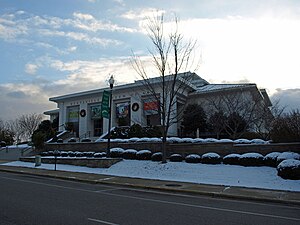Huntsville Museum of Art
 |
|
| Established | 1970 |
|---|---|
| Location | 300 Church Street Southwest Huntsville, Alabama, USA |
| Coordinates | 34°43′37″N 86°35′13″W / 34.72694°N 86.58694°W |
| Type | Art |
| Website | www.hsvmuseum.org |
Huntsville Museum of Art is a museum located in Huntsville, Alabama. It was originally established by city Ordinance No. 70-134, on August 13, 1970, which established the Museum Board of the City of Huntsville. The museum held its first exhibition in 1973 and moved to its first permanent facility at the Von Braun Center in 1975. The museum moved to its present building at Big Spring Park in March 1998.
The museum expanded in 2010 with the Davidson Center, which includes seven new exhibition galleries, the Stender Family Education Galleries, four special event facilities, and an adjacent parking lot. Before the expansion, the museum building was 52,000 square feet (4,800 m2), 15,000 square feet (1,400 m2) of it being gallery space. The museum is a member of the North American Reciprocal Museums program.
The museum's permanent collection contains nearly 3,000 items. They are divided into two collections: American art and regional artists, and other arts from Asia, Africa and Europe, which influenced these artists. The growth of the collection was supported by private donations and various foundations. Visitors can enjoy graphic works by James McNeill Whistler, John French Sloan, Joseph Stella, Robert Rauschenberg and Andy Warhol. Among artists with roots in Alabama, which works are presented in the collection of the Huntsville Museum of Art, are Richmond Burton, Nall Hollis, David Parrish and Stephen Rolfe Powell. There is also a Southern photography collection with over 200 works. The museum has also acquired works which are of particular importance for Huntsville and its scientific community, for example, a group of water color painted pictures of Huntsville and the Marshall Space Flight Center by Renato Moncini, who worked for NASA as an illustrator in the Apollo program. Another work is the Moonwalk by Andy Warhol. There are also European and Japanese prints, Chinese glassware and African sculptures. The museum is also famous for its collection of animal figures made from silver, the largest in the world, and the Italian jewelry produced by Gianmaria Buccellati.
...
Wikipedia
